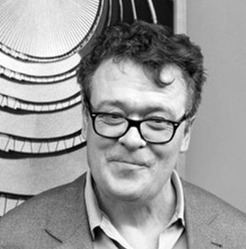
Günther Förg
Günther Förg was a prolific German artist known for his versatility in painting, graphic design, sculpture, and photography.
Biography of Günther Förg
Born in Füssen, Allgäu, in 1952, Günther Förg studied at the Academy of Fine Arts in Munich and later taught at the Staatliche Hochschule für Gestaltung in Karlsruhe twenty years later.
Upon completing his education in 1979, Förg ventured into wall paintings, marking a transition toward installation art. These monochrome surfaces, reminiscent of Kazimir Malevich or Mark Rothko, became a consistent feature of his career. The context and location of the wall upon which he worked determined the execution of these works, often characterized by horizontal and vertical divisions between contrasting fields of color.
His fascination with photography led him to travel extensively throughout Europe, with a particular focus on Bauhaus buildings. The artist's series "Fenster-Aquarelle" (window watercolors) preceded the "Gitterbilder" (grid paintings) that emerged in his work in 1992. The earlier series acted as a crossbar, creating a grid within the image, framing the space, and allowing for a fluid progression of paintings without restricting their free presentation and development. These works, much like the one Förg created for the opening of the Museum für Moderne Kunst in Frankfurt in 1991, played with architectural structures. His wall piece featured a bronze relief, offering a stark contrast to the post-modern architectural design of the museum.
In 2000, Förg was responsible for the color design of the interiors of the 1920s Villa Bodmer in Zurich. In the entrance hall, he installed two massive tubes made of raw metal.
The artist passed away on his birthday in 2013, succumbing to cancer. Throughout the last four decades, his art has been exhibited in galleries and institutions worldwide. In 1996, Günther Förg received the Wolfgang-Hahn-Preis from the Museum Ludwig. His works are part of major public collections globally, including the Museum of Modern Art in New York, Kunstmuseum Basel, Musée d'Art Moderne Grand-Duc Jean in Luxembourg, the National Gallery of Canada in Ottawa, the Stedelijk Museum in Amsterdam, and the Tate in London.
Günther Förg's Art Style
Günther Förg's abstract style was influenced by artists such as Cy Twombly and Ellsworth Kelly. In 1977, following the passing of his colleague Blinky Palermo, Förg transitioned to minimal art. This phase was followed by the creation of some of his notable works in the early 1980s. One of these works, "Alubilder," consisted of aluminum sheets adorned with linear patterns.
During this period, Förg began to incorporate photography into his art, predominantly working with large formats featuring various renowned architectural sites. His portfolio includes a significant collection of architectural photographs characterized by geometric and abstract compositions, often featuring the Bauhaus as a central motif. The grainy quality of his photographs conveyed his interest in the process of fragmentation, giving his work a modern aesthetic. This effect aimed to draw parallels with paintings. Förg's sharp-angled perspectives on Bauhaus structures in Israel and fascist buildings in Italy served to highlight the nature of these architectural creations. When presenting his photographs, he utilized thick protective glass, introducing reflections of the room and the viewer.
Förg's artistic expression was deeply rooted in modernism, evident in many of his works, which either exemplified or played with modernist themes. His early pieces predominantly consisted of black monochrome paintings, some of which were showcased in his inaugural solo exhibition at the Rüdiger Schöttle Gallery in Munich. These paintings achieved a milky, veiled effect through the combination of acrylic black paint and translucent gray.
Years:
Born in 1952
Country:
Germany, Füssen